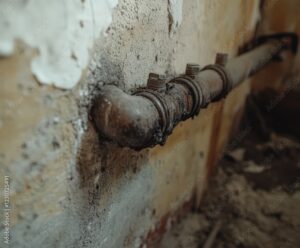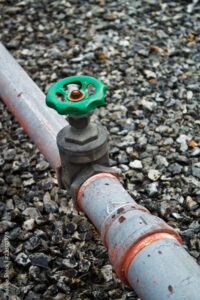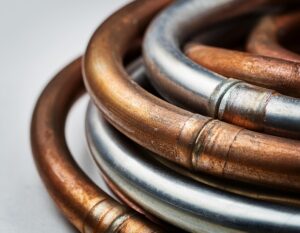When it comes to plumbing materials, galvanized steel pipes may seem like a solid, durable option. They’ve been a trusted material for years, especially in older homes, known for withstanding high water pressure and remaining cost-effective. However, as time marches on, concerns about their safety and impact on water quality have come to light.
Whether you’re a homeowner, a seasoned plumber, or an environmentally conscious individual, it’s essential to know the potential risks galvanized steel pipes can pose to water safety. Here’s what you need to know to protect your home, family, and the environment.
What Are Galvanized Steel Plumbing Pipes?
Galvanized steel pipes are made of steel coated with a layer of zinc to prevent corrosion. This coating helps extend the lifespan of the pipes and was widely popular from the 1930s through the 1980s.
While initially seen as a durable and economical solution, galvanized steel pipes age over time and begin to deteriorate. This degradation process has raised serious questions about their long-term impact on water quality.
How to Get the Best Water for Your Home or Business With Jeanne Carton – 02.29.2024
The Water Safety Concerns of Galvanized Steel Pipes
1. Corrosion and Rust Build-Up
Over time, the zinc coating inside galvanized steel pipes wears away, exposing the steel underneath to water and oxygen. This corrosion process can lead to the development of rust inside the pipes, affecting water quality in multiple ways:
- Discolored Water: You may notice rusty or reddish-brown water flowing from your taps, which is not only unappealing but also a potential warning of metal contamination.
- Restricted Water Flow: Rust and debris can cause blockages inside the pipes, reducing water pressure and severely limiting flow.
2. Lead Contamination Risks
One of the most alarming risks is lead contamination. Older galvanized steel pipes were sometimes coated with zinc containing traces of lead. Over time, the leaching of lead into the water supply can become a health hazard, especially for children, pregnant women, and those with compromised immune systems.
Even if no lead exists in the pipes themselves, they can pick up lead from other sources, such as soldered joints or connections with lead pipes.
3. Bacteria Growth
The uneven, corroded surfaces inside these pipes create the perfect breeding ground for bacteria. These microbes can build up and flow through your water system, increasing the risk of waterborne illnesses, particularly if the water is not adequately treated.
4. Release of Heavy Metals 
Alongside lead, other heavy metals such as iron and zinc can leach into the water as the pipe deteriorates. Prolonged exposure to high levels of these metals can harm your health, causing issues ranging from nausea to long-term organ damage.
5. Impact on Taste and Odor
Another common issue homeowners report is changes to the taste or smell of their water. Water flowing through heavily corroded galvanized pipes often takes on a metallic flavor or an unpleasant odor, making it undesirable for drinking or cooking.
How to Identify Galvanized Steel Pipes in Your Home 
If your home was built before the 1980s, it’s highly likely that it may still have galvanized steel pipes. Here’s how you can identify them:
- Appearance: Galvanized steel pipes typically have a gray or silvery metallic color.
- Magnet Test: They are magnetic, unlike copper or PVC pipes.
- Threaded Joints: These pipes often feature threaded connections at the joints.
Pro tip for homeowners: If you see signs of corrosion or rust near your pipe fittings, it’s time to consider an inspection by a professional.
What Are the Alternatives?
If your home still uses galvanized steel plumbing, it might be worth considering an upgrade to modern, safer materials. Here are some highly recommended options:
1. Copper Pipes
Copper pipes are a durable and long-lasting alternative, with minimal risk of corrosion or leaching. They also naturally resist bacterial growth.
2. PEX Pipes
Cross-linked polyethylene (PEX) pipes are flexible, affordable, and resistant to corrosion, making them a popular choice for residential plumbing.
3. PVC/CPVC Pipes
Polyvinyl chloride (PVC) and chlorinated polyvinyl chloride (CPVC) pipes are lightweight, corrosion-free, and suitable for both hot and cold water systems.
Steps to Ensure Your Water Quality 
If replacing your pipes immediately isn’t feasible, there are steps you can take to mitigate the risks to your water quality:
- Test Your Water: Conduct regular water quality tests to check for contaminants like lead, heavy metals, and bacteria.
- Flush Regularly: Run your taps for a few minutes after periods of inactivity to flush out any standing water with accumulated metals or rust.
- Install a Water Filter: Use a water filter certified for lead and heavy metal removal for added peace of mind.
- Professional Inspection: Have a licensed plumber conduct an annual inspection of your plumbing system to identify any emerging issues.
The Environmental Perspective 
From an environmental standpoint, galvanized steel pipes pose additional challenges. The process of manufacturing and disposing of corroded steel pipes contributes to waste and pollution. By transitioning to more sustainable materials like PEX or copper, we can reduce our impact on the environment while improving our homes’ water safety.
Final Thoughts
Galvanized steel pipes served their purpose well in their day, but as time has passed, so have their reliability and safety. For homeowners looking to ensure the health and safety of their families, as well as plumbers and environmentalists advocating for sustainable practices, replacing outdated plumbing systems is a step in the right direction.
If you’re concerned about your water quality or questioning whether your home still has galvanized steel pipes, don’t wait! Contact a local water safety expert or licensed plumber to perform a thorough assessment.
Better pipes mean safer water—and peace of mind for years to come.
For Tons of Great Free Information please hit “Like & Subscribe”
Websiteconstructionconsumeradvocacyinstitute.com
Podcastanchor.fm/galloway



